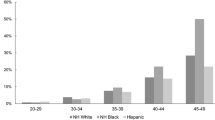Summary
Epidemiologic investigations on 309 inpatients with endometrial carcinoma were carried out in the Department of Obstetrics and Gynecology of the University of Erlangen between May 1st 66 and Dec. 31st 70.
For the purpose of comparison a control group of 234 hospitalized women with bleeding after the menopause from an atrophic endometrium was similarly analysed during the same period of time.
From our studies the following hypotheses, which coincide with those most frequently reported, could be established:
-
1.
Hypertensive and overweight women bear a greater risk of developing a carcinoma of the uterine corpus.
-
2.
Women who never became pregnant or those who had just a few pregnancies will develop an endometrial carcinoma more often than bleeding after the menopause from an atrophic endometrium.
-
3.
There is no positive correlation between the socioeconomic level and the morbidity of endometrial cancer.
-
4.
In women out of rural areas or out of small towns the diagnosis of a malignant disease of the endometrium is of greater probability.
The following hypotheses differ from those commonly reported:
-
1.
The size of the patient does not show a positive correlation to the morbidity of endometrial carcinoma.
-
2.
Women with carcinoma of the uterine corpus have neither a particularly early menarche nor a particularly late menopause.
-
3.
In unmarried women there is not a greater probability of developing a malignancy of the endometrium than in married ones.
Zusammenfassung
In der Zeit vom 1. 5. 1966 bis 31. 12. 1970 wurden in der Universitäts-Frauenklinik Erlangen epidemiologische Untersuchungen an 309 stationären Patientinnen mit einem Endometriumcarcinom durchgeführt. Als Vergleichskollektiv dienten in demselben Zeitraum stationär behandelte Frauen (234) mit einer Blutung nach der Menopause aus atrophischem Endometrium.
Aufgrund unserer Ergebnisse lassen sich folgende Hypothesen, die mit den in der Literatur am häufigsten gefundenen übereinstimmen, aufstellen:
-
1.
Hypertonikerinnen und übergewichtige Frauen haben ein erhöhtes Risiko an einem Korpuscarcinom zu erkranken.
-
2.
Frauen, die nie schwanger waren oder nur wenige Graviditäten durchgemacht hatten, erkranken häufiger an einem Endometriumcarcinom als an einer Blutung nach der Menopause.
-
3.
Zwischen der Sozialschicht und der Korpuscarcinommorbidität besteht keine positive Korrelation.
-
4.
Bei Frauen vom Land oder aus der Kleinstadt wird mit größerer Wahrscheinlichkeit eine bösartige Erkrankung des Endometriums diagnostiziert.
Die folgenden Hypothesen weichen von den in der Literatur gefundenen ab:
-
1.
Die Größe der Patientin zeigt keine positive Korrelation zur Endometriumcarcinommorbidität.
-
2.
Frauen mit einem Korpuscarcinom haben nicht eine ausgesprochen frühe Menarche und nicht eine besonders späte Menopause.
-
3.
Unverheiratete Frauen haben keine größere Wahrscheinlichkeit an einer bösartigen Neubildung des Endometriums zu erkranken als verheiratete.
Similar content being viewed by others
Literatur
Tannenbaum, A.: Relationship of body weight to cancer incidence. Arch. Path.30, 509 (1940).
Scheffey, L. C., Thudium, W. J., Farell, D. M.: Further experience in the management and treatment of carcinoma of the fundus of the uterus, with five-year end results in seventy-five patients. Amer. J. Obstet. Gynec.46, 786 (1943).
Palmer, J. P., Reinhard, M. C., Sadugor, M. G., Goltz, H. L.: A statistical study of cancer of the corpus uteri. Amer. J. Obstet. Gynec.58, 457 (1949).
Garnet, J. D.: Constitutional stigmas associated with endometrial carcinoma. Amer. J. Obstet. Gynec.76, 11 (1958).
Cohart, E. M.: Socioeconomic distribution of cancer of the female sex organs in New Haven. Cancer (Philad.)8, 34 (1955).
Wynder, E. L., Escher, G. C., Mantel, N.: An epidemiological investigation of cancer of the endometrium. Cancer (Philad.)19, 489 (1966).
Amreich, A. I.: Klinik und operative Behandlung des Uteruskarzinoms. In: Handbuch Seitz/Amreich, Biologie und Pathologie des Weibes, 2. Aufl., Bd. IV/1, S. 1066. München: Urban & Schwarzenberg 1955.
Kottmeier, H. L.: Carcinoma of the corpus. Its classification and treatment. Gynaecologia (Basel)138, 287 (1954).
Pauli, H., Kindermann, G.: Dokumentation und Auswertung geburtshilflicher und gynäkologischer Daten. Arch. Gynäk.205, 12 (1967).
Dunn, L. J., Bradbury, J. T.: Endocrine factors in endometrial carcinoma. Amer. J. Obstet. Gynec97, 465 (1967).
Documenta Geigy. Wissenschaftliche Tabellen. 7. Aufl., S. 701. Basel: J. R. Geigy AG, Pharma 1968.
Scheuch, E. K.: Sozialprestige und soziale Schichtung. Köln. Z. Soziol., Sonderheft 5. Köln/Opladen: Westdeutscher Verlag 1961.
Author information
Authors and Affiliations
Rights and permissions
About this article
Cite this article
Trotnow, S., Pauli, H.K. Zur Epidemiologie des Korpuscarcinoms. Arch. Gynak. 213, 119–126 (1972). https://doi.org/10.1007/BF00667669
Received:
Issue Date:
DOI: https://doi.org/10.1007/BF00667669




